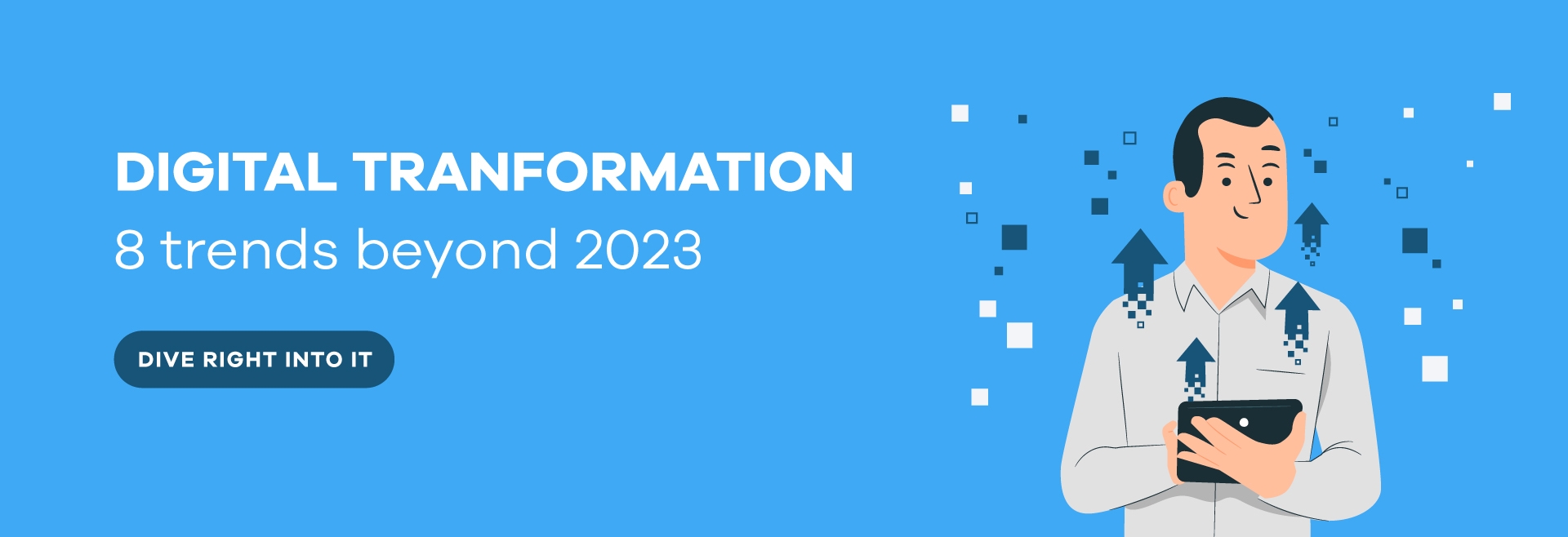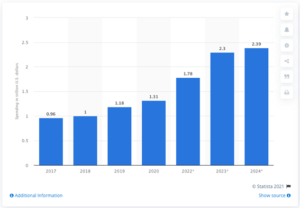
Digital Transformation: 8 trends beyond 2023
Today’s fast-paced and always-on mindset is speeding the transition.
Here are 8 trends of digital transformation beyond 2023.
Digital Transformation is nothing new. Still, it is enjoying revived attention in this post-pandemic, high-inflation age. Transitioning saves costs, makes companies more agile, drives growth, and frees people to more creative tasks. It is no wonder why so many businesses are using it as a competitive advantage – or to survive such a competitive landscape. Here’s why Digital Transformation matters now more than ever and what to expect in years to come. Topics we’ll approach:
Digital Transformation: the new normal
In 2018, 70-year-old Toys ‘R’ Us closed its doors for good. The store collapsed as it couldn’t keep up with the rise of virtual games and online shopping experience. At the same time, and almost with the same age, Domino’s Pizza, one of the world’s leading pizza takeaway brands, introduced Artificial Intelligence to reach high levels of food safety, improve traceability, and reduce costs. Domino’s kept eating away market share from long-standing competitors (pun super intended).
The key takeaways? Companies need to overcome resistance to change and make the digital leap, blending skills with technological knowledge to provide state-of-the-art services. The numbers speak for themselves; legacy companies rushed to adopt new technologies to survive, with ever-growing spending on digital transformation, reaching the striking figures of 2,39 trillion U.S. dollars in 2024.

Source: Statista
But is it worth it? Again, let the numbers do the talking and take the HP example. The brand merged 85 data centres into 3 virtual ones in 2008, improving their performance by 250% and cutting costs by 50%. One of many cases that highlight the power of digital transformation in process efficiency, overall savings, and customer experience. So,
8 trends changing the face of Digital Transformation
The strength of Digital Transformation is in how companies can integrate multiple technologies within a customer-centric strategy. Here’s how digital transformation looks like, now and in the years to come.
1. Near Shoring
This new trend of collaborative partnership has become one of the most fundamental services for companies around the world. When the objective is to simplify the process without compromising quality, near shoring allows access to the best talent in technology and a high production speed. Thus, this form of outsourcing is about more than just delivering a service – it is part of high-level decisions on decisive issues, like strategic partners who share risks and achievements.
2. Automation
Automation aims to replace manual tasks with repetitive processes so that they can work without human intervention. This trend is revolutionary because it improves efficiency and productivity to an unprecedented level. Companies still have plenty of room to automate many repetitive tasks that are not yet mediated by computers–especially in sectors where IT advances at a slower pace–and thus to free up manpower to do new things.
3. No-code and low-code development
Low-code and no-code tools are an important part of the engine of true digital transformation, as they enable non-developers to build applications using common building blocks and simple graphical interfaces, accelerating digital transformation initiatives. Not only does it eliminate digital exclusion, it also prevents teams from spending disproportionate amounts of time building and maintaining in-house tools and managing technical debt.
4. Artificial Intelligence and Machine Learning
Artificial Intelligence and Machine Learning software solutions are not just a trend but a dominant force in today’s tech world, reaching into areas as diverse as healthcare, finance, education, transportation, or automated code generation. By reducing human involvement, it makes the process less error prone. One of the most expressive examples of this technology is in the marketing space, which analyses customer’s preferences and behaviour, with reliability and speed.
5. Cloud
On-premises infrastructure is progressively being replaced by cloud alternatives, a path to remove technological barriers to remote business connectivity and collaboration. Companies need access to data and applications in multiple locations at the same time. Cloud provides flexibility and scalability that can’t be found in on-premises infrastructure. This opens the door to faster innovation and more resilience.
6. Automated software development
We will see more automated software development platforms in the coming years because of their outstanding features. From the onset, it becomes possible to launch customized software in a few weeks, even when technical talent is scarce. Automation layers are built on a flexible code base that can be customized according to customer requirements, enabling up to 90% faster time to market compared to building software from scratch.
7. Cybersecurity
For digital transformation to take place successfully, security must be guaranteed. Sensitive data needs to be processed and stored securely. Therefore, cybersecurity and privacy protection are top priority issues, especially for companies for whom data is the most valuable resource.
8. Agile and DevOps integration
Agile and DevOps best practices are key to deliver services at speed. By integrating concepts such as frequent delivery, technical excellence, consistency and simplicity, IT teams can create repeatable and automated processes to streamline work. In addition, projects are divided into short and manageable phases to implement fixes and improvements.
Near Partner, powering Digital Transformation
Untangling the best people, initiatives and tech for each project is hard work. Powerful digital technologies are available, but you must know how to wield them, which can be a massive undertaking. If you’d like that extra help to boost your Digital Transformation efforts, get in touch. We’re happy to make your transition to digital-first happen seamlessly.




